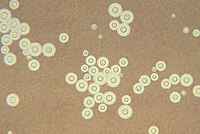
Photo from wikipedia
BACKGROUND Cryptococcus neoformans is an opportunistic fungal pathogen that causes meningitis worldwide and may be fatal in immunocompromised subjects. In Nigeria, cases have been reported with prevalence between 4 and… Click to show full abstract
BACKGROUND Cryptococcus neoformans is an opportunistic fungal pathogen that causes meningitis worldwide and may be fatal in immunocompromised subjects. In Nigeria, cases have been reported with prevalence between 4 and 13.1% in Human Immunodeficiency virus (HIV) patients depending on the study subjects. This study was designed to assess the prevalence of cryptococcosis, CD4+T cell counts and possible effect on haematological parameters in HIV seropositive subject in Nnewi, South-Eastern Nigeria. METHOD A total of four hundred and twenty-nine (429) subjects were recruited for the study. Of these, two hundred and ninety (290) were HIV positive and one hundred and thirty-nine (139) were HIV seronegative subjects recruited from the voluntary counseling and testing (VCT) unit and HIV care clinic at Nnamdi Azikiwe University Teaching Hospital Nnewi, Anambra State, Nigeria. Their ages were between 18-80 years. One hundred and thirty nine (139) apparently healthy HIV seronegative subjects were recruited as controls. Blood samples were taken for C. neoformans by Antigen lateral flow assay (CrAgLFA), HIV testing, CD4+T cell, platelet and Full blood count (FBC). RESULTS Our results show that of the two hundred and ninety (290) who were HIV positive subjects investigated for cryptococcosis, 4 (1.4%) tested positive for CrAg of whom 1(25%) were male and 3(75%) were female. All those with cryptococcosis had their CD4 count below 200 cells/μL, three of them were on ART and one was not. There were significant differences in the CD4 counts (P<0.05) between those infected and not infected with C. neoformans. None of the control group tested positive to cryptococcosis. CONCLUSION Widespread use of anti-retroviral therapy may have reduced C. neoformans infection. However, the threat remains and there may be a possibility that women may be a more vulnerable population.
Journal Title: Journal of infection and public health
Year Published: 2019
Link to full text (if available)
Share on Social Media: Sign Up to like & get
recommendations!